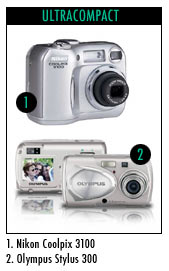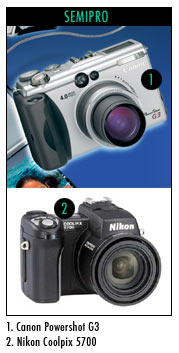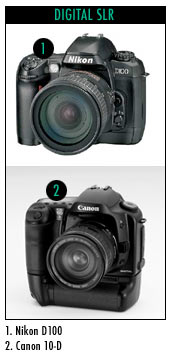NEW YORK (Money Magazine) -
Which digital cameras are best? It depends on how you want to use them. There are four basic kinds.
Ultracompact
Small enough to fit in a change purse, most models fix all the camera settings (except the zoom) automatically. The upside is you won't need to study all sorts of possible tweaks in a manual; the downside is you won't get many tweaks. Their lenses are also small, which affects the quality of shots. But they go anywhere, and there is logic in the maxim that the best camera is the one you will use. Here are two we like.

Nikon Coolpix 3100 (list price: $350): This three-megapixel camera (the greater the pixel count of an image, the higher the resolution of that image) barely covers your palm, has a great Nikon Nikkor lens, and uses compact-flash memory and standard AA batteries or rechargeables. It's also easy to use out of the box.
Olympus Stylus 300 ($399): A three-megapixel version of the film world's most popular camera, the Olympus Stylus, it has everything to hate in a digital camera: a proprietary battery and nonstandard memory. (Industry standard memory media, like Secure Digital or Compact Flash cards, are easier to find and cheaper, as are standard batteries, like good old AAs.) It also has everything to love: great images, a solid feel in your hand and, unlike virtually all other digital cameras, the versatility to be used in rain, snow and, cautiously, in a pool.
Compact
These can fit inside a jacket pocket and give you more control over your pictures. (They can also capture short movies.) This is the most crowded category. For most users, they offer the best combination of excellent images, features and convenience. These two stand out, each for its own reasons.

Minolta S414 ($399): This may be the market's best deal. The four-megapixel camera is a good $200 cheaper than comparable models, has a great lens and uses compact-flash memory and AA batteries. The S414 also allows you to grow as a digital photographer, letting you choose its idiotproof automatic mode or play with the different settings -- like shutter speed and aperture -- that serious photographers crave.
Ricoh Caplio RR30 ($299): Available only through QVC and a few online retailers, the three-megapixel RR30 overcomes the chief fault of digital cameras: shutter lag. Most digitals have a slight but maddening delay between the time you press the shutter and the moment they snap the picture. The RR30 shoots instantaneously, making it uniquely suitable for photographing fast-action sports. It's designed to use SD-card memory and any of six different kinds of batteries, including standard rechargeables. And the $299 price makes the RR30 a real bargain.
Semipro
| Money's Guide
|

|
|
|
|
This is the next step up in price, size and features. You'll need a camera bag, but you'll also get lots of controls and a big, powerful, built-in optical zoom lens. Semipro cameras demand about twice the investment of compact cameras but offer most of the controls that serious amateurs (and an increasing number of professional photographers) need. Consider these two.

Canon Powershot G3 ($799): A four-megapixel camera with a 3x zoom, it sets the current standard for image quality. People who like reading manuals will be rewarded with the ability to fine-tune the G3 to capture any setting or mood. It uses CF memory and a Canon battery.
Nikon Coolpix 5700 ($999): It has five megapixels, an 8x zoom, superior glass, lots of flexible controls -- all in a package that's ideal for traveling and capable enough for serious photographers. If you don't need quite as big a zoom, the similarly sophisticated Coolpix 5400, with a 4x lens, is $200 cheaper.
DIGITAL SLR
The big daddy of digital cameras -- and the one that offers the best-quality pictures at the highest resolution. Digital SLRs (for "Single Lense Reflex") so closely follow the click, click, click of the classic film cameras used by pros that even Austin Powers would feel at home with one. And like film SLRs, the digital models let you use the vast variety of interchangeable lenses that camera makers have long been building for their best film cameras. If you've already invested in a collection of lenses that you love, consider a digital SLR, but be prepared to put out at least $1,500. If not, the semipro models offer nearly the same functions without the added weight or cost.

Nikon, with its Nikon D100, and Canon, with its Canon 10-D, have been the most aggressive in what's considered the consumer end of the digital-SLR market. They keep leapfrogging each other, and Canon is now ahead with its new, supremely capable six-megapixel 10-D. The Canon lists at $1,500, down from $30,000 for its professional predecessor a few years ago.
Consumer demand is outstripping production, however, so you may have to put your name on a waiting list to buy one. With digital SLRs, you should think about lenses first. If you already own a lot of Nikon glass, the D100 ($1,700) will also bring you into the digital age nicely, only a few steps behind Canon owners. Or maybe ahead, since the D100 doesn't have a waiting list.

|

